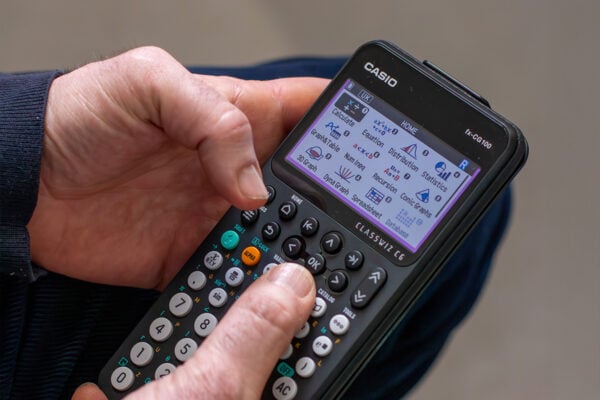Teacher and students share first thoughts on the Casio fx-CG50

The fx-CG50 graphic calculator is a powerful tool. It’s capable of plotting graphs in Cartesian, parametric and polar forms, calculating and graphing probability distributions, analysing lines and planes in 3D, and a lot more.
We appreciate, however, that simply listing a calculator’s functionality only counts for so much. The truest account of its value and benefits will always come from the teachers and students who use it.
Recently, we had the opportunity to visit Brakenhale School, where we spoke to Vicky Moore, Lead Practitioner for Maths, and year 12 maths students Mika and Marine, shortly after they used the fx-CG50 for the first time.
Read on to find out what they thought of the experience.
First impressions of the fx-CG50
A common theme in the responses we received from Vicky, Mika and Marine was the positivity of their first impressions when they picked up the fx-CG50.
Both students commented on how the colour display adds to the overall appeal and usability of the calculator, and were also struck by the number of apps on the main menu, which highlights the range of functionality available.
Vicky told us that the excitement generated by the calculator in her classroom was unlike anything she had seen in a maths lesson before.
“The fact that students are so excited about using these tools – it’s one less barrier we’re going to have when it comes to encouraging them to do their homework or get on board in the lesson,” she said.
“Students having tools in front of them that get them engaged and get them excited – that’s everything a teacher could possibly want.”
Putting the calculator to use
First impressions are one thing, but what about the reality of learning the calculator and using it efficiently?
Vicky was in little doubt that – thanks to their innate familiarity with technology and digital interfaces – students will comfortably take the lead here, often showing the teacher how to perform operations and access functions.
“We should absolutely encourage students to find those new tools on the calculator and explore it, because they’re the next generation, they’re the ones who are going to show us the way in the years to come,” she said.
Both Mika and Marine were enthusiastic about learning how to use the fx-CG50 and exploring the potential benefits it could offer in the future.
“It’ll take some time to get used to, but with the initial functions we were introduced to, it was easy to memorise and the labels are really clear, so even if you forget you can work it out for yourself,” Marine said.
“I think it will be really useful… I can see myself using it in all my lessons from now on.”
The students also commented on the time-saving benefits of the fx-CG50, highlighting key features and functionality such as graphing, which makes it quick and easy to view an equation or a table of data in graph form.
“Instead of having to write out all of the points and plotting them onto a graph, we can just input the functions and have it all show up, which is a lot easier,” Mika said.
The student feedback we received also indicated that using the fx-CG50 can enable much more efficient collaboration in the classroom, making it easier for fellow learners to display information and explain things to one another.
“You could definitely fit in more learning in less time with the graphic calculator,” Mika added.
Supporting learners at all levels
One principle that is particularly important to us at Casio is that all learners – not only the most able or privileged students – should be able to benefit from technologies like the fx-CG50 graphic calculator.
This is something we’ve previously discussed with Rhiannon Rainbow, School Improvement Lead for Maths at the Greenshaw Learning Trust, who said it’s “hugely important” for students to have access to the best possible technology.
“I’ve seen graphic calculators used really powerfully with some of the most vulnerable and most disadvantaged students,” Rhiannon told us.
Vicky also picked up on this point, noting that having access to a tool that brings them closer to the answers to tricky questions can do wonders for building student confidence.
“It provides the growth mentality that we want students to have,” she said. “Students who have used the graphic calculator today have shown their enthusiasm for it and that will go a long way in encouraging them to take on maths, even if they’re not the strongest of mathematical brains.”
Vicky offered some examples of topics at varying levels of difficulty to illustrate the range of possible applications of the fx-CG50.
She spoke about how many of her students are daunted by quadratic equations, so were excited to see how the calculator offered an alternative route into exploring this topic through graphing and visualisation.
For more advanced students exploring statistics at A-level, Vicky highlighted the value of the calculator’s deviation functionality, predicting that her school’s statistics specialists will be “amazed” when they see what the handset can do.
Vicky isn’t the only teacher who has picked up on the power of the fx-CG50 as a tool for studying statistics.
When we spoke to James Davis, Associate Assistant Headteacher and Maths Teacher at Newstead Wood School, about how he uses the calculator to prepare his students for exams, he told us he was a “big fan” of Distribution mode.
This app lets you calculate probabilities and graph discrete and continuous distributions, which James said had gone down particularly well with his A-level classes.
If you’re interested in learning more about the fx-CG50 and its extensive functionality, you can find a library of hundreds of dedicated resources on our website.
You can also sign up for a free training session. This will give you an expert introduction to some of the calculator’s key functionality, such as graphing and equation solving, and demonstrate how it can support your teaching and help students improve their understanding.



